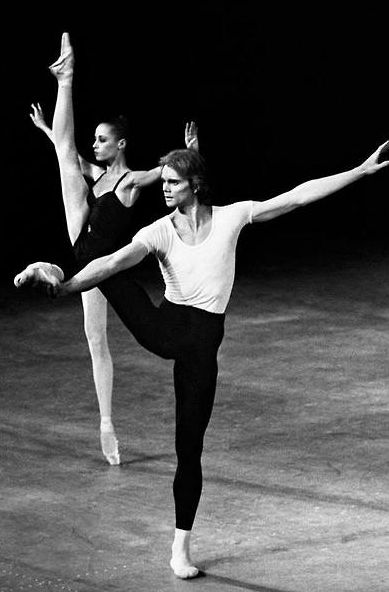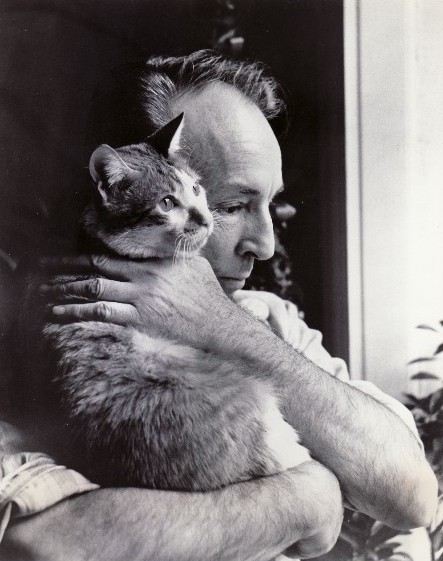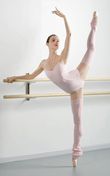The saving grace of the week was dancing Balanchine’s The Four Temperaments. I have been doing the First Theme in 4T’s for such a long time that it feels like it was made on me, though of course it wasn’t. (This is one of Balanchine’s gifts: his ballets are so effortlessly habitable. A mere hour after learning his choreography one feels intrinsically rooted in the movement and the music.) Balanchine created 4T’s for the inauguration of Ballet Society in 1946. He had privately commissioned the Paul Hindemith score in 1940 and only later decided it should become a ballet.
The First Theme feels more like yoga than ballet, which is probably why it was such a welcome distraction. It consists of sustained, contorted poses—one for each note in the score. It is pure and literal: when the strings’ notes ascend, I get lifted up. When the piano is heavily clanged, I am accordingly dropped nearly to the ground and dragged offstage during its lingering rumble. Extended notes for the strings become slow promenades in which my legs wrap around my partner’s ankle, thigh, and neck. It is an impassive, asexual Kama Sutra. It requires an intense focus
When I first saw the ballet as a student at SAB (with Maria Kowroski in the First Theme, and Wendy Whelan and Jock Soto in Sanguinic, I’ll never forget) I remember thinking that it did not seem to showcase four different temperaments at all. I was struck by that fact anew in Saratoga this summer. The three Theme pas de deux are relatively emotionless, except for the fact that the First and Third Theme women are awkwardly hauled into the wings like albatrosses. But then the following movements—Melancholic, Sanguinic, Phlegmatic, and Choleric—are all of a mopey piece. I wondered to myself in the audience if I had misread the program upon that first viewing; wasn’t Wendy supposed to be in the happy movement? When the ballet ended and a bright allegro movement never came I was confused, although I loved the ballet instantly.
Sanguinic, as the word pertains to the Hippocratic humors, is defined as an excess of blood which supposedly makes for a confident, cheerful personality. I’ll give Balanchine the confident part, but the cheer is hard to discern in the ballet. The Sanguinic pas de deux is anything but joyful until the very last high grand jété lift off, which seems hopeful at best. When the Sanguinic man leaves the woman onstage alone for her solo she walks backward amid the swarm of four corps girls called “the cockroaches” with stern determination. The way the pas de deux couple collapses together after the finale step is anything but euphoric. The stage-skimming circle of lifts they perform twice does not scream elation but rather resignation. If this is the purportedly upbeat movement of the ballet, I do not believe that happiness could possibly have been what Balanchine was after in this case.
The names we give to the supporting roles and particular dance segments of 4T’s also tend toward darkness. In addition to the cockroach quartet of the Sanguinic section, there are the two demi-soloist “mosquitoes” who buzz around and harass the male lead in Melancholic. Then there is the military quartet of corps women who come out kicking and thrusting their hips in Melancholic (one of the great ab workouts in all of ballet!) who always remind me of a fascist army. The stabbing, contrapuntal dance performed by the five principal women in the finale of the ballet is called “the devil’s dance.” The off-balance, pelvis-first grand rond de jambe promenades introduced in the Sanguinic section and repeated by the four principal couples in the finale are called “the creeps.” Much of the imagery throughout the ballet is arachnidan.
Even the Phlegmatic section does not seem to be truly indifferent. The man in Phlegmatic is uncaring in a glass half-empty way. I think of Kenny Wayne Shepherd’s Blue on Black chorus. And isn’t total apathy in itself a form of depression? The Choleric woman does indeed project anger, until the Melancholic and Phlegmatic men come to manipulate her into joining the grand battement army in the last phrases of music. The three leads dissolve into the ranks of the mosquitoes and roaches and kick at the audience with dead stares like zombies. It is chilly and powerful.
Balanchine says of this work in his New Complete Stories of the Great Ballets: “Although the score is based on this idea of the four temperaments, neither the music nor the ballet itself make specific or literal interpretation of the idea. An understanding of the Greek and medieval notion of the temperaments was merely the point of departure for both composer and choreographer.” If the humors are a point of departure, Balanchine and Hindemith were surely embarking for the shores of Hades instead of Elysium. Towards the end of the piece, the three Theme women end up aligned in supported arabesques like pointer dog versions of the Three Fates. Then the whole cast assembles onstage for a unison step of violent kicks, jutting ilia, and collapsing torsos. When the whole stage freezes except for the Choleric woman, the hunched-over, curved-arm, default pose of the Melancholic and Phlegmatic groups resembles menacing ravens. The four principal couples are arrested with pelvises locked together in what looks like dispassionate mid-coitus.
There is a reason that the spiritually uplifting Concerto Barocco is performed in all white and The Four Temperaments is done in all black. In Looking at the Dance, critic Edwin Denby writes of the ballet: “It appears to have the dispassionate ferocity of a vital process; its subject is the ‘four temperaments’ (or humors) of medieval endocrinology and it suggests the grandiose impersonal drama of organic energies. It is an impersonal drama that appears to be witty, cruel, desperate and unconsoling, like that of our time.” And yet—at the last moment The Four Temperaments changes gears.
The music, which for most of the finale is a thunderous battle of piano vs strings (one that the Theme men Andrew Scordato and Alan Pfeiffer hilariously act out in the wings every time before they enter to awaken the bee’s nest that is the Choleric woman) suddenly shifts to anthemic harmony in the last few bars. The zombie army kicks and lunges in two strict rows, but the four principal couples weave through them and the women are lifted above the fray in optimistic grand jétés on the major chords. They look like birds or fish exploding out of the waves. I would not say that the effect is completely jubilant, but it does imply—to my mind during this rough patch, at least—a nobility of suffering. For Albert and for Eddie this seemed appropriate this summer.
I am happy that I am set to return to SPAC mid-August to perform with the Philadelphia Symphony Orchestra. Perhaps I will get to enjoy the experience a little more. This is not to say that there weren’t moments of levity: my farmer housemates, the local masseuse Suzanne, the chiropractor Alicia, the costumers, the stagehands, the people of Putnam Market, Common Grounds, Moby Rick’s, Mrs. London’s, Soave Faire, the farmer’s market, etc. were as lovely as ever. I am enthused about my purchase of first editions of Alice in Wonderland and Through the Looking Glass with illustrations by Ralph Steadman from the wonderful Lyrical Ballads. And it was a true pleasure to be able to listen to Mindy Aloff and Deborah Jowitt’s pre-show lectures at the Hall of Springs. But sometimes everything in the world just feels tinged by doom and gloom and you can’t fight it. Balanchine and Hindemith apparently understood this. The Four Temperaments made me feel that that was okay.



 RSS Feed
RSS Feed